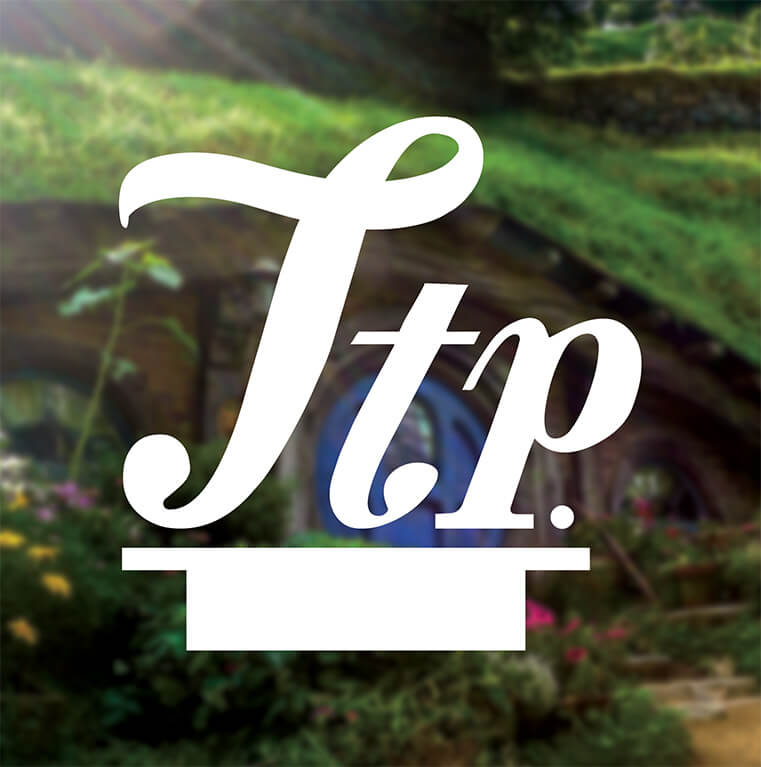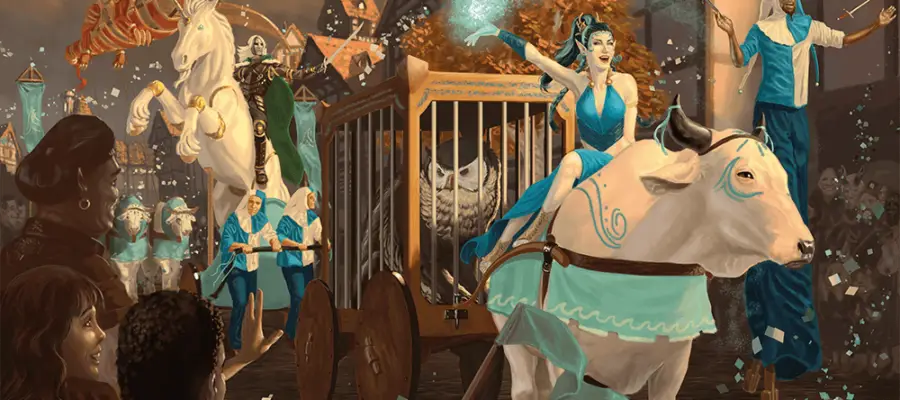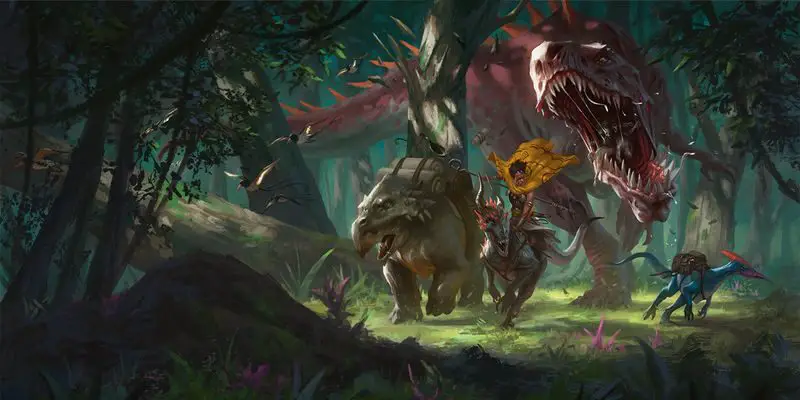TTRPG music and ambience featured image is credited to Wizards of the Coast’s D&D 5e Waterdeep: Dragon Heist.
Disclaimer: This article contains affiliate links that add gold to our coffers.
The music goes quiet as the Paladin strikes a deadly blow against the hag. She stumbles back, gasping. A choir begins to chant. She pulls her ribs apart to reveal her final form as the choir crescendos to a peak, and the true fight begins.
In another town, ocean waves grow quiet as the party enters a crime scene. It’s replaced with the sound of buzzing flies and a slow cello as the party investigates the details of a grisly murder.
Further in the session, the sound of a crackling fire fills the room as the group takes a moment to pause and roleplay their characters sitting around a campfire at the end of a long day of adventuring. They open up about their pasts and discuss their fears and hopes for the future as lackadaisical crickets chirp and an easy wind rustles through the trees.
Music and ambience, when used appropriately, can enhance your sessions. It creates dramatic moments, adds tension, and increases player immersion. The three examples from above are how I’ve personally used music and background noise in my sessions. If you’ve never used music before or have had trouble implementing it into your sessions, this guide will answer your questions and help you bring immersion and drama to your table.
Pros and Cons
While music can add a lot to the D&D experience, it won’t, like all tools, fit into every table. When considering whether to add music and ambience, you need to be aware of what it can bring and what it could take away.
The Pros of Using TTRPG Music
- Background ambience can add a great level of immersion to your game. Choosing the right sounds can help your players put themselves in the shoes of their character and imagine the scene. This may even help them gain confidence to roleplay.
- Ratcheting the music up in a dramatic moment can add tension to the scene, such as the music suddenly starting as you say “roll initiative” or changing to an intense track as the boss reveals their final form.
- Music or ambience can build upon descriptions to even further establish mood and setting: an eerie violin for horror, pop-synth music for cyberpunk, fast and upbeat music for a festival, or dramatic forlorn horns during a death scene.
The Cons of Using TTRPG Music
- Managing what is playing, starting and stopping depending on what’s happening, does add extra work for the Dungeon Master. It is one more thing the DM needs to track in-session.
- Finding what music or ambience to play can add more prep time, especially if you want to have specific sounds or music at certain cues in the session.
- Having something playing underneath the session, especially something with words, can distract players. Additionally, if they have selective hearing, it can make it harder for them to hear what other players are saying.
- If players use a white noise to fall asleep, like rain, using it in-session can make players sleepy (this has actually happened to me).
In-Game Use of TTRPG Music
When I run games, I prefer to use music for combat and dramatic moments and use ambience to fill the rest of the gaps. So, when traveling, I’ll have a windy forest sound playing along with the sound of a horse and cart. Sometimes, I’ll use a light instrumental playlist, but I mostly stick to ambience. When a battle happens, though, I’ll start playing battle music. There’s a lot more space and silence in combat, so I’ve found having some rousing music helps keep players engaged for longer.
I also like stacking multiple tracks on top of each other. For a rowdy bar, I may play three or four different tavern ambience tracks. I might also layer music and ambience, such as adding fire noises on top of the battle music for a forest fire fight.
Player as DJ
The DM doesn’t have to be in charge of the music. In a group I’m a part of right now, I DJ for the DM. I choose what music to play based on what’s happening, where the party is, or the DM’s request. This helps alleviate stress on the DM’s part, because they don’t have to worry about making sure the right music is playing while juggling all the other responsibilities of a DM, but it still brings the benefit of having music and ambience playing in the session.
Leitmotifs
A leitmotif is a musical phrase that is used to represent a place, person, or idea (think of it as a theme song). While they add extra work for the DM, leitmotifs can make your villains or grand locations memorable. In a recent campaign I ran, the main antagonists were a group of eldritch beings inhabiting rotting bodies who had strange goals the players were trying to unravel. Whenever the players would meet one of these beings, I would have this specific song play. The creepiness of the song, and the recurring nature, meant that simply playing the track would let the players know what was coming.
Tips for Online Sessions
Generally, there are two ways to play music for online sessions. The first is to send the players a link to the playlist or track when you want them to listen to it. This makes it difficult for dramatic twists in the music, but it is the simplest way and creates player choice if they find music too distracting. This also allows stacking of tracks.
The second method is using your voice system to play tracks, which depends on how you are playing online. Some systems, like Roll20, allow you to upload your own music and play it through their voice system. There are also third-party tools that will allow you to play music through your microphone.
Tips for In-person Sessions
I recommend using an external speaker over your computer’s speaker. It’ll provide better quality, directional effects, and help maintain consistent sound levels. Keep the audio quiet; it’s more important for your players to be able to hear each other than your rocking battle music. Keep in mind that you will also have to adjust volumes during the session to account for differences in track volume and for players’ engagement.
Resources and Tools for TTRPG Music
Here are resources I use and enjoy when I need music and ambient sounds for my TTRPGs.
YouTube
YouTube provides a wide range of both music and ambience tracks. I find it easiest to simply look up what you need (e.g. “tavern ambience with music”, “thunderstorm ambience”, and “dark dungeon music”) or to create or find playlists that you like to use.
Watch out for songs and playlists that rely on monetization too much if you need to avoid ads. Advertisements break the immersion you achieve through music. Even a video that lasts for several hours can have ads sprinkled throughout.
Tabletop Playlists on YouTube

I run a project called Tabletop Playlists that’s a YouTube channel dedicated to creating playlists for use in D&D games. It includes playlists dedicated to a wide variety of uses (like battle music, dungeon music, and locational ambience) and vibes (like Cyberpunk, Fey Wild, and Viking). It’s always a work-in-progress, and I appreciate suggestions and requests!
Spotify
Spotify works best for music playlists, as there’s a good collection of soundtracks and original music from fantasy composers. You can find many already-created playlists for your use.
Building Your Own Soundtrack
If you’re particularly dedicated or want to flex your creativity, you can build your own ambience tracks. Several sites, like Freesound, contain free audio samples that have various use requirements, such as crediting the original creator.
Copyright Disclaimer
If you stream or record your sessions, be cautious of what tracks you’re using. Some creators will allow their music or ambience to be played with any game as long as they’re credited. Others will want payment or will not want their music being played at all. Using music you don’t have permission to use can land you in big trouble. You can be penalized with demonetization, a DMCA complaint, or even the removal of your video.
It’s best practice to contact the creator beforehand and ask for their permission. Always be prepared to be turned down.
Conclusions about TTRPG Music
Playing music or ambience may not be for every table or DM. If you haven’t used it before, give it a shot. Music can add immersion and engagement to your table. If you make use of pre-generated resources, it requires only a little extra time and effort on your part.
Don’t forget to
Check out other DM tips here.




